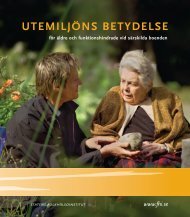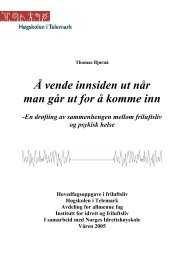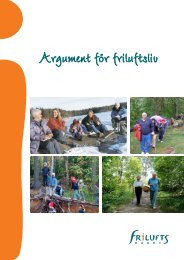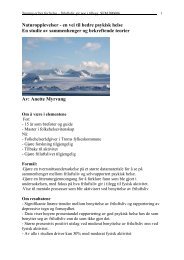Green Care: A Conceptual Framework - Frisk i naturen
Green Care: A Conceptual Framework - Frisk i naturen
Green Care: A Conceptual Framework - Frisk i naturen
You also want an ePaper? Increase the reach of your titles
YUMPU automatically turns print PDFs into web optimized ePapers that Google loves.
model is that people develop self-identity and derive a sense of fulfilment<br />
through daily occupations. Meaningful and successful experiences<br />
develop confidence and feelings of mastery which motivate them to<br />
meet new challenges. Occupational therapy interventions may include<br />
building personal capabilities, modifying environments, or reconsidering<br />
occupational processes and goals (Christiansen et al, 2005). These too are<br />
outcomes which green care programmes aim to achieve.<br />
5.2 Therapeutic communities as green care<br />
communities<br />
Therapeutic communities for adults, in specific mental health settings,<br />
came about as a result of two British war time experiments, at Northfield<br />
Military Hospital in Birmingham and Mill Hill in London (Kennard, 1998).<br />
Both were innovative group based programmes for aiding the recovery of<br />
battle shocked soldiers, based on psychoanalysis and social learning theory;<br />
they included little horticultural or agricultural activity. From these, the<br />
modern therapeutic communities in the British National Health Service<br />
have evolved. However, although they are often identified as the origin of<br />
therapeutic communities, their work was predated by important movements<br />
in mental health generally called ‘moral treatment’, more than a century<br />
beforehand. For example, Samuel Tuke founded the Retreat Hospital in<br />
1796, as a reaction by the Quakers against the poor conditions then existing<br />
for the treatment of mental illness. In these more humane settings of care,<br />
hospital farms were an important part of the therapy and ideas of selfsufficiency<br />
were included.<br />
Since the middle of the twentieth century, specialised therapeutic<br />
communities have also developed in British prisons, using a democratically<br />
structured programme of group therapy. These have limited but variable<br />
access to therapeutic horticultural activities.<br />
Illich (1976) strongly criticised the way in which people’s bodily condition<br />
was made pathological and often worse by over-zealous medicalisation<br />
and “expropriation of their health”. Therapeutic communities, although<br />
often residing in old-fashioned institutional settings, espoused a very<br />
different view to the traditional medical one: rather than health and its care<br />
being expropriated by irresistible and powerful external forces, healing<br />
is substantially the responsibility of the individuals concerned and their<br />
55















